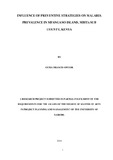INFLUENCE OF PREVENTIVE STRATEGIES ON MALARIA PREVALENCE IN MFANGANO ISLAND, MBITA SUB COUNTY, KENYA

View/
Date
2015Author
OWUOR, OUMA FRANCIS
Type
ThesisLanguage
enMetadata
Show full item recordAbstract
Malaria is preventable and treatable yet it remains the number one killer disease in Africa. In 2010 an estimated 219 million cases of malaria occurred worldwide and 660,000 death cases were reported in Africa alone according to the 7th President‘s Malaria Initiative (PMI) report of April 2013. Malaria remains the leading cause of morbidity and mortality in Kenya with close to 24 million of the population at risk of infection. Mbita Sub County has a malaria prevalence of 30% compared to 38% Nyanza and western Kenya. Outpatient health facility morbidity data in Mfangano Island shows that there were very high incidences of malaria reported in 2013 as compared to all other diseases reported in selected facilities. The purpose of this study was to investigate the influence of preventive strategies on malaria prevalence in Mfangano Island, Mbita Sub County. This study was guided by the following objectives: To examine how utilization of mosquito nets influence malaria prevalence among households in Mfangano Island, to assess the extent to which environmental hygiene influences malaria prevalence on households in Mfangano Island, to determine how malaria knowledge seeking behaviour influences malaria prevalence among households in Mfangano Island, and lastly to assess the extent to which malaria prophylaxis drug influences malaria prevalence among households in Mfangano Island, Mbita Sub County. The study had a target population of 9,873 and a sample size of 373 households. Data collection instruments used in this study were questionnaires and key informant interviews (KIIs). Questionnaires were administered to 373 household heads in Mfangano Island and 355 questionnaires were returned and analysed representing 95% return rates. Key informant interviews were used to collect qualitative data from 10 respondents chosen by purposive sampling technique. They were District Malaria Control Coordinator, District Disease Surveillance Coordinator, 2 Health facility in-charges, District Health Records Information Officer, 2 Community Health Extension Workers, Area Chief, Area assistant chief and a village elder. The instruments used were organized into sections intended to extract relevant information from the respondents according to the study objectives. The test retest technique was used to ensure reliability of research instruments while validity was ensured through pilot testing and reviews. Data obtained was cleaned, verified and analyzed by Statistical Package for Social Sciences (SPSS) version 20. The study findings indicate that 86.2% own mosquito nets. Among these, 78.9% have nets that are treated by a chemical. The findings on net utilization reveal that 76.6% use the net always as compared to 13.5% who use the nets occasionally and 2.5% do not use at all. Poor attitude at 67.6% was cited as one of the reasons why some people do not use mosquito nets and 14.4% of the respondents cited that the nets are stuffy. The study established that those who clear their compound occasionally had higher cases of malaria at 52% as compared to those who clear their compound 2-3 times a week at 21%. The study also established that health promotion is needed for knowledge dissemination about malaria prevention and behaviour change. The findings showed that only 9% of the responses were sure that malaria is contracted through a bite from a female anopheles mosquito. And on knowledge of malaria prevention, 83.1% cited using a combination of strategies, sleeping under a net, clearing of the compound, using mosquito coil and taking anti-malarial medicine while 17.9% advocated for either of the strategies. The study further established that most people at 58.3% buy antimalarial medicine as a preventive measure against suspected malaria. It was concluded that all the preventive strategies discussed have an influence on malaria prevalence in Mfangano Island. Results from correlations showed significant and positive correlations among variables under study. The researcher then recommended that malaria prevention require a multi-faced approach and that all preventive strategies should be employed together if malaria burden has to be reduced in Mfangano Island.
Rights
Attribution-NonCommercial-NoDerivs 3.0 United StatesUsage Rights
http://creativecommons.org/licenses/by-nc-nd/3.0/us/Collections
The following license files are associated with this item:

